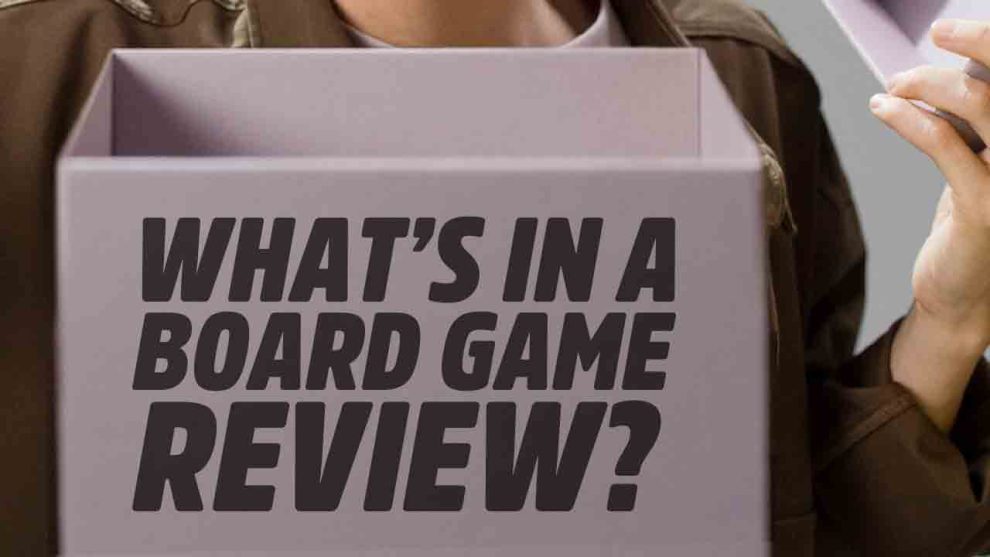Here at Meeple Mountain we talk a lot about why we play games. Looking over our archives, you’ll find plenty of reasons in articles like: Why I Love Board Games (And Why I Think You Should Too), Why Do We Game – The Expectation of Enjoyment, and Top 6 Reasons Why I Play Games, Explained in the Ten Hundred Most Used Words. We’ve dug into specific niches of gaming, from The Amazing Cognitive Benefits of Puzzle Games to Board Games as Science Communication to Why Play Solo? We’ve explored RPGs and Escapism (The Value of Childlike Imagination) and gotten personal with How Board Games Changed My Life.
Yet we don’t talk much about why and how we review games. My colleague Thomas Wells has an insightful article that separates review from critique in the context of colonialism as a theme, but critique is not what I am after here. I want to examine the basic bedrock of reviews. What even is a game review? Why should we read or watch reviews? What purpose do they serve? Who is the audience? Is it just about free games and Internet clout or is there a deeper meaning to what we do?
These aren’t easy questions to answer, if only because there isn’t really a defined procedure for reviews, no well-worn rubric against which we can base our work. Reviewers are largely self-taught and self-appointed. That isn’t to say that all reviewers are equal. It requires a lot of creativity and talent to do well in what is now a very crowded field. Every reviewer needs to find their own voice, and that voice determines both what they focus on and how they describe it.
Even just answering the most basic question of what a review is can be tough. A how-to-play video probably isn’t a review, but a playthrough might be. A single sentence could qualify while a lengthy analysis of strategy doesn’t. For my purposes, I think a solid working definition is that a game review is “any piece of third-party media content which attempts to use objective and/or subjective framing in order to persuade the audience of the game’s perceived quality or value”.
In other words, a game review (no matter its form) is a work created by someone who is not involved with the creation of the game which highlights facts or feelings associated with the game to provide a guideline regarding who might enjoy the game and why.
There are a lot of lurking assumptions here that could get us into dangerous philosophical territory, but I think this is a solid starting point. To break it down a bit further, I think that every review is a mix of four major aspects. These aspects impact the tone and style of the review and also to some extent determine who the intended audience might be.
The four aspects as I see them are instructional, transactional, promotional, and experiential. Not every review will have all these elements, and rarely will each area be given equal weight. Part of the process of becoming a reviewer (or engaging with a review!) is figuring out which of these aspects appeal to you most. By exploring these different angles, we can help parse our preferences.
Instructional
Instructional content is the most straightforward level on which a game review operates. Unlike some other forms of art which might be reviewed and critiqued, games require a working knowledge of structure to be understood. How many players can participate? What is the goal of the game? What kinds of actions are taken and how?
Teaching the rules by themselves isn’t a review. Without this information, however, the review feels incomplete. Some reviews spell out the intricacies of play to help potential players understand exactly what the experience is like, while others provide a loose overview to orient the audience around key concepts. How much depth the reviewer provides can be a major factor in how their review is interpreted.

In some cases, a review can also offer additional context to the game. This might take the form of a brief history of the game’s design and development, a discussion of the designer’s other work, or even a treatment of the real-world elements that shape a game’s theme. Not every review needs this kind of content, but when used well it can greatly enrich a player’s understanding of the game.
Instructional descriptions about the gameplay and components can also be useful when discussing a game’s financial value, a facet I call…
Transactional
Transactional content focuses on the game as a physical object and commodity. At a basic level, the focus here is on the box and components; at a higher level, the emphasis is on whether there’s “enough” game provided for the expected retail price. Accordingly it is slightly less straightforward than instructional, because it gets into something that’s hard to judge: what is a game worth? Is there a single price point at which a game tips from “not worth it” to “definitely worth it”? Can a game be overpriced if players enjoy it? Can a game be considered a good value even if the players don’t enjoy it?
Many reviewers, myself included, skirt this question more often than not. Talking About Games: The Price Is Wrong from Dan Thurot (Space-Biff) highlights some of the reasons why reviewers might avoid the topic of price and makes an excellent case for why reviewers should avoid it. Turning every review into a transactional analysis is fundamentally missing what gaming is about.
At the same time, reviewers owe it to their audience to remember that price is a factor for many people. Each year, thousands of games hit the shelves. Colorful boxes sprawl across every social media platform. Crisp component images and beautifully detailed illustrations flood Kickstarter. There has truly never been a better time for gamers…yet that also comes with a massive cost (literally). To keep up to date on the latest and greatest titles requires phenomenal expense.
The decision of whether to purchase any given game often requires knowing whether a game is made cheaply or well, whether it will provide days’ worth of entertainment or become dull in a few minutes, or whether the pieces offer a luxurious tactile experience beyond what the price would indicate. Many gamers invest in large or expensive games knowing full well that if they don’t like it, they can easily sell it on to get some of their money back. Others wait until a game has dropped in price before they pick it up, hoping to get the “right” value for their purchase.
All this comes into play when a consumer is considering a game. Even without commenting on price directly, reviewers should do their best to indicate whether the expected value lines up with real-world cost. Of course, this is complicated by the most challenging aspect of reviewing, which I describe as…
Promotional
Promotional content–i.e., using reviews in a way deemed favorable for a designer or publisher–is an aspect that many reviewers need to navigate carefully. When done correctly, reviews can bring meaningful attention to lesser-known titles or publishers, build enthusiasm for upcoming projects, and help consumers find the right game for them. When mishandled, promotional content hangs a massive cloud over not only the reviewer, but the entire review community.
I want to be very clear: in my experience, I have never seen or heard of reviewers taking payment from publishers for content without disclosing that information. Most paid content that I am aware of takes the form of non-review materials: how-to-play videos, paid previews, etc. (As of this article’s publication, Meeple Mountain has only ever received payment for one piece: our video preview of Aroma, which includes clear indication that it was paid content.) Though I cannot prove it, my belief is that the number of people who receive payment for review content is much, much lower than the general public believes.
For more context around paid and unpaid content creation, consider watching the “Show Me the Money” episode of Table Talk from Rodney Smith or reading Jamey Stegmaier’s article “Is It Unethical to Pay the Media to Form and Broadcast Their Opinion?”
However, game publishing is still a business, and to act otherwise is folly. Publishers and reviewers have a symbiotic capitalist relationship: publishers typically provide a free copy of the game for review, in exchange for coverage that may (or may not) influence future sales. This is particularly obvious for Kickstarter campaigns, where publishers are hoping to directly convert the audience to backers of their game. The act of reviewing a Kickstarter is naturally promotional; the game will not exist if people do not back it, and releasing a review requires specific timing and coordination with the publisher.

Note that most publishers–again, in my experience–do not place any strings or requirements on the contents of a review. The old adage about any press being good press holds true: broadly speaking, an honest review will still help the audience decide whether to purchase a title, even if the review itself is unfavorable. Not every game is for everyone, after all. If a specific reviewer doesn’t like it, but the game looks interesting, who’s to say whether that reviewer is correct?
I’ve heard many people complain that reviewers are biased when their reviews regularly skew positive. The premise is that they must be getting paid to say good things about the game(s) in question. The truth is much simpler: reviews are hard work. It takes a ton of time and energy to produce a review. Just getting a few plays in can take a dozen hours. Adding images of components, writing and editing a script for video reviews or the full text of a written review, communicating with the publisher about rules questions or timing restrictions, posting and publicizing the review, and so forth can add a dozen hours more. That’s a lot of effort for a game you don’t like! For that reason, reviewers are generally careful about what they take on. Reviewers often select games that appeal to them personally, will be popular enough to effectively require coverage, or are interesting enough conceptually that they’ll make for a good review even if the game itself isn’t enjoyable. These factors subtly stack the deck in favor of positive reviews even without payment being involved.
Beyond that, there are times when reviewers truly are promoting a specific game, even if not for the publisher’s reasons. Magic: The Gathering doesn’t need much help from me, but I do think it’s an instructive way to learn a lot about games and game design. Is this article promotional? Yes, undoubtedly. I’m literally telling you to play this game! But is it nefarious? I hope not. My intent is not to sell Magic cards, it’s to encourage people to try a game I’ve loved for decades. Here at Meeple Mountain we do this all the time in our aptly-named Games We Love series.
While it might seem like reviewers push sales based on publisher demand, the reality is often more complicated, more human than that. Game reviewers generally start as game players and enthusiasts. Like anyone, we have our favorites and our bugbears. Those preferences undoubtedly influence our perspective. By honestly addressing any conflicts of interest or hidden biases that might be lurking, we can make sure that our reviews promote games in a healthy way that builds trust between reviewer and audience.
Of course, the real test of a reviewer’s honesty is what they have to say about the game experience. In other words, it’s about the aspects that are…
Experiential
Experiential content is what many of us think of when we think about game reviews. What is it like to play this game? What feelings or thoughts might its mechanics evoke? Is it challenging or easy? Is it fun to play solo, or does it require a large group? How does its art and theme support or subtract from the overall experience?

It is tempting to think of these questions as having either objective or subjective answers. The mechanics of a game exist independently of my feelings on them; they are objective. The experience I have when playing the game is subjective; if a game reminds me of a family vacation I took 30 years ago, I certainly can’t pretend that everyone will feel the same connection.
The truth is that neither of these are strictly adequate because the experience of playing a game involves constantly extrapolating from the objective elements to the subjective ones and back again. A game mechanic that requires dice is inherently neither good nor bad, but could be either based on how I feel about rolling dice generally or even the specific dice being rolled (badly weighted or unpleasantly sized dice might also fall under the banner of transactional review). To evolve this further, each roll of the dice is tied to my experience rolling other dice in other games. I can compare this game to others in part by how the dice feel in my hand, how they influence my decisions over the course of the game, whether I have more or less flexibility with how the dice results are used, and so on. The use of dice involves certain objective mechanics and components while engendering certain subjective responses, and it’s this type of interplay that creates the experience of playing a game.
The art of experiential reviewing is in parsing out how all the different elements of the game interact with the players’ various perceptions, emotions, and thoughts. It is the study of consciousness through the act of play. It requires deciphering which experiences will be more or less universal, which will be personal, and which will impact some players but not others. This is frequently a hard line to walk. What bothers me may not bother you. My favorite game might fall flat in your group or even on the wrong night. For this reason, I and many reviewers tend to steer away from absolute assessments in reviews. There’s no value in telling someone that the game they love is bad, and not much more in telling them that a game they hated is actually quite good. The important part is why we feel that way.
Conclusion
So what makes a good review? Depends on what you’re looking for. Personally, when I write a review, I’m interested in the experiential elements above all else. For me, games are all about evocative themes, brain-tickling decision space, and fun interactions with other players. I want my reviews to capture the feeling, the essence, of the game more than the specifics. But I also need to make sure I’m thinking about those other aspects of a review: making the rules summary clear, highlighting any unusual components, and addressing whatever biases I might have toward the game or its publisher.
I often hear the advice that gamers should seek out those reviewers whose preferences match their own. Hopefully this article provides a framework for review consumers to do just that by analyzing reviews in terms of how they deliver on these four aspects. And as reviewers, I believe we can use these ideas to do a better job of signposting our preferences and styles.
In the end, though, reviews are conversations, not commandments. What makes games so endlessly interesting is that the only way to experience them is to play them, and the only experience that really matters is your own.











Add Comment